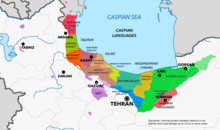Gilaki language
| ||||||||||||||||||||||||||||||||||||||||||||||||||||||||||||||||||||||||||||||||||||||||||||||||||||||||||||||||||||||||||||||||||||||||||||||||||||||||||||||||||||||||||||||||||||||||||||||||||||||||||||||||||||||||||||||||||||||||||||||||||||||||
Read other articles:

Galaxy in the constellation Lynx NGC 2798NGC 2799 (left) and NGC 2798 (right) by NASA/ESA/SDSS/Judy SchmidtObservation data (J2000 epoch)ConstellationLynxRight ascension09h 17m 22s[1]Declination+41° 59′ 58″[1]Redshift0.005757[2]Heliocentric radial velocity1726 ± 10 km/s[2]Apparent magnitude (V)12.32[1]Apparent magnitude (B)13.04[1]CharacteristicsTypeSB(s)a pec[2]Other designationsNGC 2798, Arp 283, IRAS…

List of events ← 1576 1575 1574 1573 1572 1577 in Ireland → 1578 1579 1580 1581 1582 Centuries: 14th 15th 16th 17th 18th Decades: 1550s 1560s 1570s 1580s 1590s See also:Other events of 1577 List of years in Ireland Events from the year 1577 in Ireland. Incumbent Monarch: Elizabeth I Events January 11 – Palesmen sends delegates to England to complain of the burden of the cess.[1] June – James FitzMaurice FitzGerald is in Spain plotting rebellion in Ireland with the support…

This article relies excessively on references to primary sources. Please improve this article by adding secondary or tertiary sources. Find sources: Working Waterfront Maritime Museum – news · newspapers · books · scholar · JSTOR (April 2010) (Learn how and when to remove this message) The Working Waterfront Maritime Museum is a Maritime Museum located in Tacoma, Washington, USA. The museum sits on the Thea Foss Waterway. Along with the Discovery Wharf Ch…

Provinsi di Iranاستانهای ایرانOstânhâ-ye IrânJuga dikenal sebagai:OstânاستانKategoriNegara kesatuanLetakIranJumlah wilayah31Penduduk591.000 (provinsi Ilam) – 13.323.000 (provinsi Tehran)Luas5.833 km2 (2.252 sq mi) (provinsi Alborz) – 183.285 km2 (70.767 sq mi) (provinsi Kerman)PemerintahanPemerintah provinsi (Pemerintah nasional)Pembagian administratifCounty Provinsi di Iran menurut jumlah penduduk pada 2021 Provinsi di Iran menurut kepa…

Cet article concerne le concept sociologique général. Pour sa variante sur Internet, voir Réseau social mobile. Pour l'outil utilisé à cette fin, voir Média social. En sciences humaines et sociales, l'expression réseau social[1] désigne un agencement de liens entre des individus ou des organisations, constituant un groupement qui a un sens : la famille, les collègues, un groupe d'amis, une communauté, etc. L'anthropologue australien John Arundel Barnes a introduit l'expression…

此条目序言章节没有充分总结全文内容要点。 (2019年3月21日)请考虑扩充序言,清晰概述条目所有重點。请在条目的讨论页讨论此问题。 哈萨克斯坦總統哈薩克總統旗現任Қасым-Жомарт Кемелұлы Тоқаев卡瑟姆若马尔特·托卡耶夫自2019年3月20日在任任期7年首任努尔苏丹·纳扎尔巴耶夫设立1990年4月24日(哈薩克蘇維埃社會主義共和國總統) 哈萨克斯坦 哈萨克斯坦政府與�…

Cet article présente la liste des lauréats et nommés français aux Golden Globes. Cette page répertorie les nominations et les récompenses qui concernent les Français, ainsi que les productions ou coproductions françaises (ce qui inclut les films étrangers financés par la France). Catégories Cecil B. DeMille Award Sorte de « Golden Globe d'honneur » qui récompense la carrière d'un cinéaste connu. Année Lauréat 1959 Maurice Chevalier Golden Globe du meilleur film dramat…

UK school that specialises in certain subject areas This article is about specialist schools in the United Kingdom. For specialist schools in other countries, see specialist school. For special needs schools, see special school. A sign for Loreto Grammar School in Altrincham with its specialist status in maths and science advertised. Specialist schools[a] in the United Kingdom (sometimes branded as specialist colleges in England and Northern Ireland) are schools with an emphasis or focus…

Artikel ini membutuhkan rujukan tambahan agar kualitasnya dapat dipastikan. Mohon bantu kami mengembangkan artikel ini dengan cara menambahkan rujukan ke sumber tepercaya. Pernyataan tak bersumber bisa saja dipertentangkan dan dihapus.Cari sumber: SMA Negeri 1 Jonggol – berita · surat kabar · buku · cendekiawan · JSTOR SMA Negeri 1 JonggolSmoerayInformasiDidirikan16 Januari 1978 (SMPP Timur Bogor atau Filial)8 Oktober 1982 (De Jure, SMA Negeri 1 Jonggol)A…

Indian writer (born 1956) For the banker and RBI Governor, see Amitav Ghosh (banker). Amitav GhoshFRSLGhosh in 2017Born (1956-07-11) 11 July 1956 (age 67)[1]Calcutta (now Kolkata),West Bengal, IndiaOccupationWriterNationalityIndian[2]Alma materUniversity of Delhi (BA, MA)University of Oxford (PhD)GenreHistorical fictionNotable worksThe Shadow Lines, The Glass Palace, Ibis trilogy, The Great DerangementNotable awardsJnanpith AwardSahitya Akademi AwardAnanda PuraskarDan D…

Neurotransmisión: la terminal del axón (neurona presináptica en amarillo) libera el neurotransmisor, que activa receptores en la célula postsináptica (verde). En la terminal del axón, se muestran los pasos del ciclo de las vesículas y el neurotrasmisor. La neurotransmisión (del griego: transmissio= paso, cruzar, viene desde transmitto= envío, dejan pasar), también llamada transmisión sináptica, es el proceso mediante el cual se liberan las moléculas de señalización llamadas neurot…

У этого термина существуют и другие значения, см. Люди Икс (значения). Люди Иксангл. X-Men Жанры супергеройский боевик приключения фантастика драма Создатели Эрик Леуолд Марк Эдвард Эденс Сидни Айуонтер На основе Люди Икс Роли озвучивали Норм Спенсер[вд], Катал Джеё До…

Solid metallic material with disordered atomic-scale structure Samples of amorphous metal, with millimeter scale An amorphous metal (also known as metallic glass, glassy metal, or shiny metal) is a solid metallic material, usually an alloy, with disordered atomic-scale structure. Most metals are crystalline in their solid state, which means they have a highly ordered arrangement of atoms. Amorphous metals are non-crystalline, and have a glass-like structure. But unlike common glasses, such as wi…

摩纳哥用途民用旗(海陸)、政府旗(海陸)比例4:5啟用日期1881年4月4日 用途政府旗比例2:3 用途民用旗(海陸)、政府旗(海陸)比例2:3 摩納哥國旗是一面由紅、白兩色橫條組成的旗幟,长宽比例为4:5,於1881年4月4日採用(紅、白的樣式在1393年已經出現)。除比例外,图案皆與印尼國旗和德國黑森邦邦旗相同。红色与白色来自于摩納哥國徽与亲王徽章。 政府旗 政府旗 …

First United States Navy aircraft carrier For other ships with the same name, see USS Langley. USS Langley underway, 1927 History United States Name Jupiter (1912–1920) Langley (1920–1942) Namesake Jupiter Samuel Pierpont Langley BuilderMare Island Naval Shipyard Laid down18 October 1911 Launched24 August 1912 Commissioned7 April 1913 Decommissioned24 March 1920 Recommissioned20 March 1922 Decommissioned25 October 1936 Recommissioned21 April 1937 RenamedLangley, 21 April 1920 Reclassified Fl…

У Вікіпедії є статті про інші значення цього терміна: Клен (значення). КленПеріод існування: пізній палеоцен — наш час Acer saccharinum Біологічна класифікація Царство: Рослини (Plantae) Клада: Судинні рослини (Tracheophyta) Клада: Покритонасінні (Angiosperms) Клада: Евдикоти (Eudicots) Клада: Розиди…

Nepali writer, born 1983 This article has multiple issues. Please help improve it or discuss these issues on the talk page. (Learn how and when to remove these template messages) This article may need to be rewritten to comply with Wikipedia's quality standards. You can help. The talk page may contain suggestions. (June 2022)This article needs additional citations for verification. Please help improve this article by adding citations to reliable sources. Unsourced material may be challenged and …

Amerlcan actor and television host Dorian GregoryGregory in 2006Born (1971-01-26) January 26, 1971 (age 53)Washington, D.C., U.S.Occupation(s)Actor, television hostYears active1991–present Dorian Gregory (born January 26, 1971[1]) is an American actor and television host who played Darryl Morris on the television show Charmed (1998–2005) and was the fourth and final permanent host of Soul Train, replacing Shemar Moore.[2] Background Gregory was born in Washington, D…

Stefano Argercolo de Pendinellisarcivescovo della Chiesa cattolicaUn suo ritratto nella cappella dell'Assunta della chiesa matrice di Galatina Incarichi ricopertiVescovo di Nardò (1439-1451) Arcivescovo di Otranto (1451-1480) Nato1403 a Galatina Deceduto11 agosto 1480 ad Otranto Manuale Stefano Agercolo o Agricoli de Pendinellis (Galatina, 1403 – Otranto, 11 agosto 1480) è stato un arcivescovo cattolico italiano. Indice 1 Biografia 2 Bibliografia 3 Altri progetti 4 Collega…

بادغان إسلامي إمام رضا تقسيم إداري البلد إيران إحداثيات 37°20′58″N 46°10′23″E / 37.349444444444°N 46.173055555556°E / 37.349444444444; 46.173055555556 تعديل مصدري - تعديل بادغان إسلامي إمام رضا هي قرية في مقاطعة مراغة، إيران. عدد سكان هذه القرية هو 3,361 في سنة 2006.[1] مراجع ^ تعداد سكان ج�…

